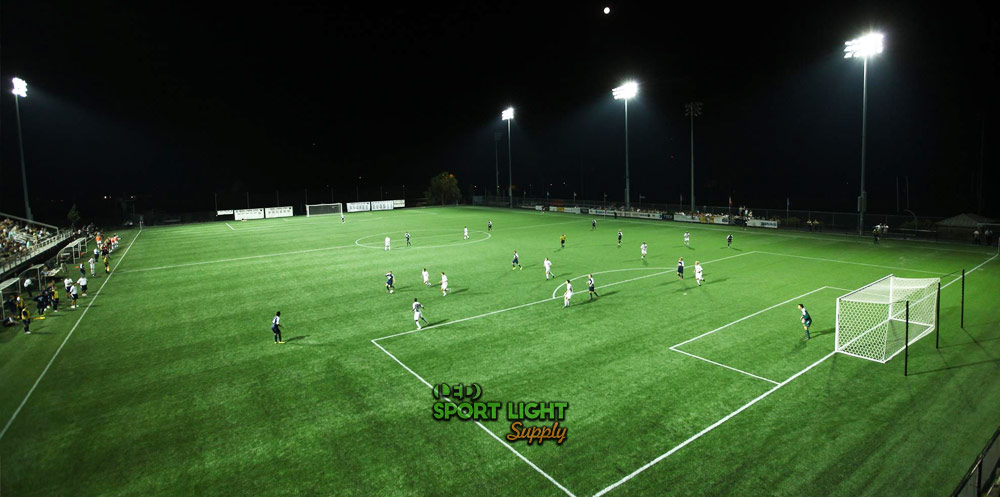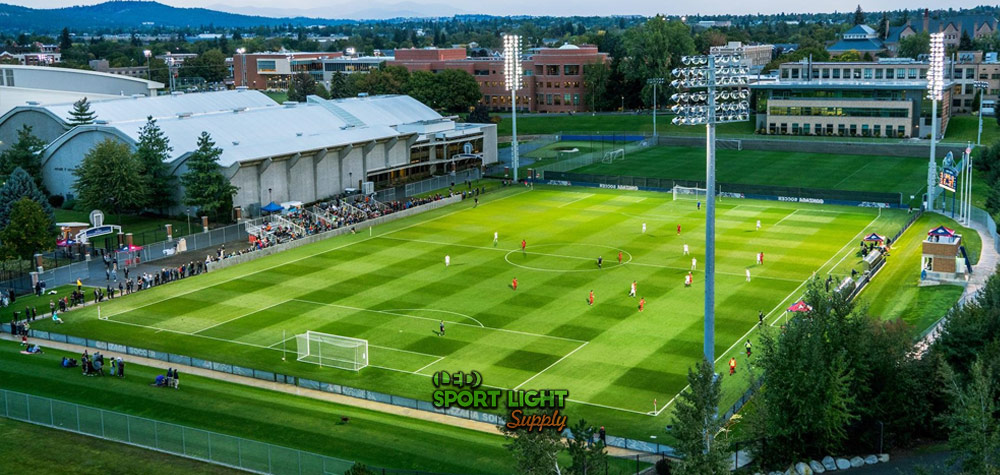Understanding how a field is illuminated is crucial for professional sports, and the science behind it has become quite specialized. For those unfamiliar with the intricacies of field lighting, this guide serves as a valuable reference tool. It not only highlights the advantages and disadvantages of different lighting options but also assists in addressing specific field lighting needs. If your role involves illuminating a field, it’s essential to be aware of these key considerations and their practical applications.
Table of Contents
ToggleUnderstanding Side Lighting on Sports Fields
Side lighting on a sports field involves strategically placing lights along the sides of the field to achieve broad and even illumination. This setup typically utilizes the four corners of the field as ideal locations for installing lights. By positioning lights diagonally from these corners, side lighting aims to cover the field from various angles, thereby enhancing visibility for both players and spectators. This method of illumination is designed to create a comprehensive lighting system that ensures adequate brightness across the entire field.
The effectiveness of side lighting greatly depends on the size and type of the playing field. In stadiums and arenas, where fields are larger and require higher intensity lighting, lights are mounted on high mast poles. These poles’ height and distance from the field are crucial factors that influence the lighting’s overall effectiveness. The placement and power of these lights must meet specific lumen requirements to ensure uniform coverage and minimize shadows.
Challenges and Solutions with Side Lighting

While side lighting offers many benefits, it is not without its challenges. One major drawback is the potential for unwanted shadows, which can obscure players’ movements and impact the viewing experience. Shadows are often a result of the diagonal angles from which the lights are positioned. These shadows can be particularly problematic in high-stakes games where precise visibility is critical.
To address these issues, corner lighting is introduced as a solution. Corner lighting involves placing additional lights at the corners of the field, targeting the areas where shadows are most prominent. This configuration helps to reduce and eliminate the shadows created by the diagonal side lighting. By illuminating the field from multiple angles, corner lighting enhances visibility and ensures a more uniform distribution of light.
The Role of Corner Lighting in Sports Fields

Corner lighting serves as a valuable enhancement to traditional side lighting systems. It is especially beneficial in professional sports venues, where lighting requirements are more stringent due to broadcasting needs and industry standards. In large stadiums and arenas, corner lighting is often implemented alongside side lighting to provide a higher level of illumination. This approach is crucial for meeting the demands of television broadcasts, where slow-motion cameras and high-definition replays require impeccable lighting to capture every detail of the game.
Typically, standard sports fields, such as those used for soccer and football, utilize a lighting system that includes additional lamps along the edges of the field. This system is commonly referred to as the 6-pole or 8-pole lighting configuration. For professional venues, the corner lighting setup may involve even more lights to meet the specific standards required by professional leagues and broadcasters.
Side Lighting vs. Corner Lighting: Understanding Their Benefits and Drawbacks
When it comes to illuminating sports fields and stadiums, both side and corner lighting systems offer distinct advantages and limitations. Rather than viewing these lighting approaches as mutually exclusive, it is important to recognize that they can complement each other effectively. Each has its own set of benefits and drawbacks, which can be optimized when used together.
| Corner Lighting | Side Lighting | |
| Cost Considerations | One of the primary concerns with corner lighting is the height required for installation. Corner lights are typically mounted on high masts situated at each corner of the field. This setup can be challenging, particularly in large stadiums with complex structures. The height and distance of these lights necessitate precise calculations to ensure adequate lumen levels are achieved. This often involves using mathematical formulas to determine the appropriate amount of illumination needed for each corner.
Corner lighting systems can be expensive to operate, especially when using traditional metal halide or high-pressure sodium lamps. The running costs of these older lighting technologies are significant due to their high energy consumption. Transitioning to LED corner floodlights offers a cost-effective alternative. LED lights provide substantial savings over time due to their lower power consumption and longer lifespan, resulting in reduced maintenance costs. Investing in LED corner lighting can lead to significant long-term savings, making it a financially advantageous choice. |
Once corner lighting is installed, additional side lighting may be needed to address darker patches on the field. The use of side lights in a 6-pole or 8-pole configuration can enhance the overall illumination by filling in these gaps. LED side lights are particularly effective in this regard because they require less power compared to traditional lighting options and are positioned closer to the edge of the field. This not only improves visibility but also offers a cost-effective solution for achieving more uniform lighting across the playing surface.
High schools and colleges often use a 6-pole setup, but an 8-pole configuration is more effective for covering darker areas. Placing these lights behind spectator bleachers or near goal areas can further enhance field illumination, providing better visibility for players and spectators alike. |
| Glare Issues | High mast corner lighting systems are prone to glare, particularly when using floodlights with smaller beam angles. Traditional lighting technologies, such as metal halide or high-intensity discharge lamps, often require glare shields to mitigate this issue. However, these solutions are not always fully effective, leading to discomfort for both athletes and spectators.
LED lighting has improved glare control due to its narrow beam angle and the ability to use reflectors. While LEDs can reduce glare more effectively than older technologies, improper setup of high mast poles can still result in issues that impact the viewing experience. Players, in particular, may notice the difference in glare when playing on fields equipped with high mast lighting. |
Side lighting generally produces fewer glare problems compared to high mast systems. The high beam angle of side lights allows for better illumination of closer objects, which helps to reduce glare. When using a 6-pole or 8-pole configuration, side lights can effectively cover smaller regions of the field, contributing to improved overall visibility. The lower beam angles of side lights also help balance the lumen distribution, minimizing glare issues and enhancing the viewing experience. |
| Shadow Reduction | While corner lighting provides substantial coverage, shadows can still be a problem. Even with evenly distributed mast pole lights, certain areas of the field may remain dimly lit, creating shadows that can affect gameplay and visibility. This issue is particularly problematic for professional sports fields where precise lighting is crucial. To address these shadows, additional side lighting is often necessary to fill in the gaps and provide uniform illumination across the entire field. | Side lighting helps to reduce the shadows created by corner lighting. By adding lights along the edges of the field, side lighting fills in darker areas and improves overall visibility. This approach is especially effective for fields used in amateur and local sports, where corner lighting alone may not be sufficient. The addition of side lights ensures that shadows are minimized and that players and spectators have a clearer view of the action. |
| Heat Generation | High-intensity discharge (HID) and metal halide lights used in corner lighting can generate significant heat, which can be problematic, especially when multiple lights are clustered together. This heat buildup can lead to equipment failures and increased maintenance requirements. However, LED lights are a better alternative for corner lighting as they have built-in heat sinks that allow for efficient cooling. The advanced design of LEDs helps manage heat effectively, even in adverse weather conditions, ensuring reliable performance. | Side lights, particularly those using LEDs, generate less heat compared to corner lights. LED technology is designed to dissipate heat effectively, which prevents overheating and reduces the risk of equipment failure. The lower heat output of LED side lights makes them a suitable choice for sports fields, as they provide bright illumination without the associated heat issues of older lighting technologies. Additionally, LED lights can offer high color temperatures, enhancing the overall experience for both players and spectators by creating a more vibrant and energetic environment. |
Conclusion
Corner and side lighting each offer unique benefits and challenges. Instead of choosing one over the other, the key is to use both together. Corner lighting provides broad coverage but may introduce glare and shadows, while side lighting helps fill in gaps and reduce these issues. By combining both types, you can achieve optimal illumination, enhancing visibility and overall playing conditions for any sports field.
